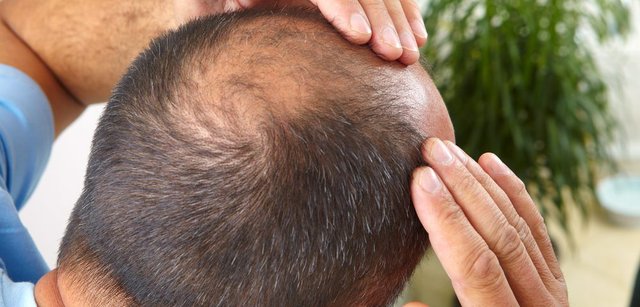Healing baldness with osteoporosis treatment
Hi dear steemians...
Most of the time, taking medication comes with side effects. Sometimes, these are surprising. They can even become useful. The evidence, researchers say that a treatment against osteoporosis could push our hair!
Today there are only two treatments for baldness (androgenetic alopecia as specialists call it): minoxidil and finasteride. But both have unwanted side effects such as itching, low libido or headaches. And their effectiveness often leaves something to be desired.
In search of a new alternative - both more effective and better tolerated by future patients - researchers at the University of Manchester (United Kingdom) are interested in the action of cyclosporine C ( That's it). This medication is traditionally administered to prevent transplant rejection or to fight autoimmune diseases. Among its mild side effects: the fact that it stimulates hair growth.
Promote the growth of the hair follicle
A thorough study of the molecule has allowed the researchers to conclude that CsA reduces the expression of a protein called SFRP1; this protein inhibits the development and growth of tissues, especially that of hair follicles.
The researchers then found that an osteoporosis drug, WAY-316606, was targeting the same protein. "With the same interesting results," says Dr. Asim Shahmalak, but a priori without the side effects of CsA. Experiments have already been conducted on the hair follicles of dozens of volunteer donors. However, a clinical trial remains essential for the confirmation of the efficacy of the treatment ... and its safety.
Traitement contre la calvitie : on en est peut-être à un cheveu !
On est remonté jusqu'à la racine de la calvitie ! Une molécule, la prostaglandine D2, serait particulièrement bien représentée dans les tissus dégarnis et empêcherait la croissance des cheveux. Des pistes de traitements sont déjà avancées, et les chercheurs espèrent que ces médicaments se retrouveront sur le marché d'ici cinq ans.
Everyone remembers this ritual. During the 1998 FIFA World Cup, French defender Laurent Blanc was still kicking the ball on goalkeeper Fabien Barthez before the match kicked off. Twenty years later, at the 2018 edition, will this affectionate gesture still be possible?
Not sure, say researchers at the University of Pennsylvania (Philadelphia), who announced in Science Translational Medicine have discovered a molecule that would be involved in baldness. A lipid, prostaglandin D2 (PGD2), appears to play a role in inhibiting hair growth.
This news is interesting since Androgenetic Alopecia (AAG) affects 80% of the male population before the age of 70. For the time being, only a predisposing factor had been identified, and again among a minority of bald men, and concerns a mutation on the testosterone receptor gene. The other causes are still largely unknown, and the drugs currently used to treat AAG have been discovered by chance, since they were intended against other pathologies.
PGD2, a molecule to tear off the hair
In this study, several elements support the involvement of PGD2 in hair loss, or more precisely in the inhibition of their growth. At first, bald men played the game, allowing researchers to compare the expression of genes in regions still hairy and those completely bald. For 81 genes, the activity was noted as being more important, with a particular mention to the gene promoting the synthesis of PGD2.
Thanks to other experiments, prostaglandin has again demonstrated its ability to prevent hair growth. It has also been shown in mice during hair follicle growth cycle a peak of PGD2 expression at the beginning of the regression phase. Or when the researchers transplanted human follicles into mice and applied the suspect molecule, the hair never grew. Finally, they found that genetically modified mice that did not express prostaglandin in the skin showed exactly the same symptoms as in human alopecia.
Treatment for baldness: inhibit the inhibitor
All indications are that PGD2 is an important inhibitor of hair growth, and therefore a major player in baldness. As a treatment, it is envisaged to block its activity in the scalp. And the work might already be premature.
Because scientists have noted in their study that PGD2 activates a membrane receptor called RCPG-44 (G 44 protein-coupled receptor). When the prostaglandin binds to this molecule, a reaction cascade is triggered in the cell and blocks the growth of the hair. The researchers therefore believe that inhibiting RCPG44 would block the activity of PGD2.
However, this membrane receptor is also involved in other pathologies, especially in asthma. And pharmaceutical companies are already working on the development of drugs that can stop it from working. Clinical trials are engaged. Thus, the authors of the study hope to be able to recover the active ingredient and divert it to introduce it into a cream to be applied to the areas likely to lose.
Nothing says on the other hand that it will be possible to make regrow hair at the bald ones. However, the hope is in place since these same scientists were able to show in 2011 that even in men with alopecia, the follicular stem cells remained intact, PGD2 only prevent their proliferation. By blocking the prostaglandin, they hope to trigger cell multiplication and thus capillary growth.
A balance not to break?
George Cotsarelis, the man who oversaw this work, is still careful. He recalls that we already knew that prostaglandins were involved in hair growth. But sometimes in the other direction. Thus, latanoprost, an analogue of prostaglandin F2-alpha stimulates the growth of eyelashes, while prostaglandin E2 promotes coat growth in mice.
The researcher therefore suggests that these molecules can compensate each other, and that there may be a balance system for normal development. Offering a treatment that would block PGD2 activity could lead to imbalance and other effects, not necessarily desirable. So let's just show a little more patience ...
